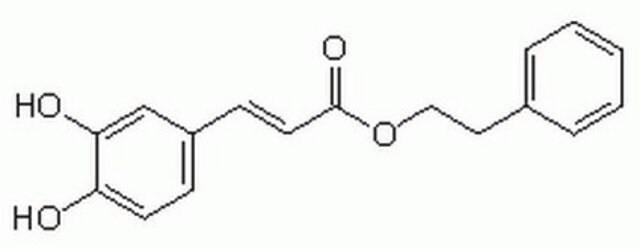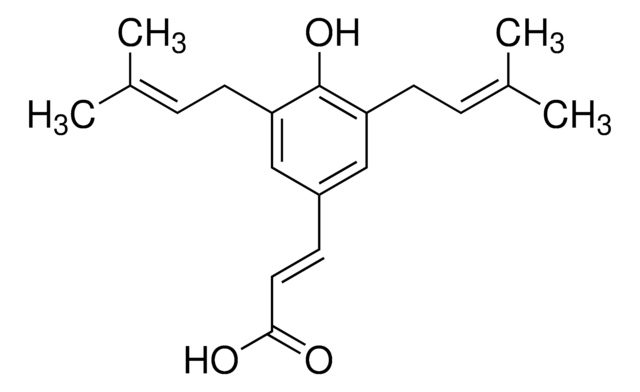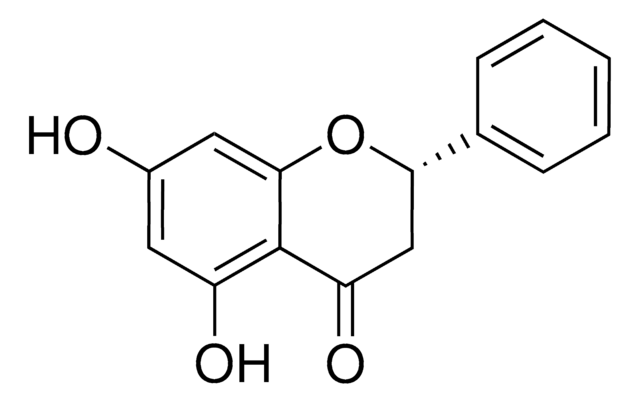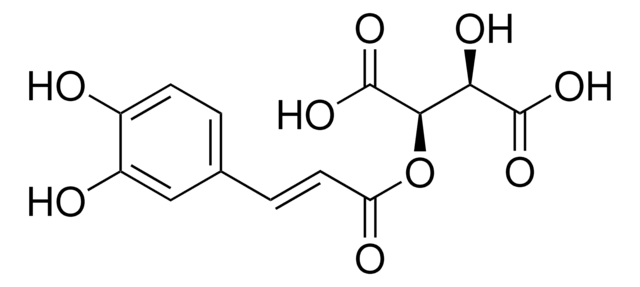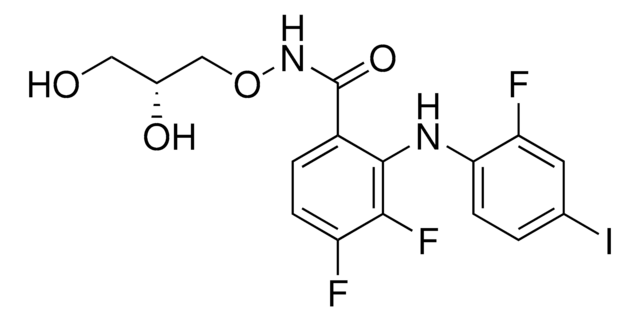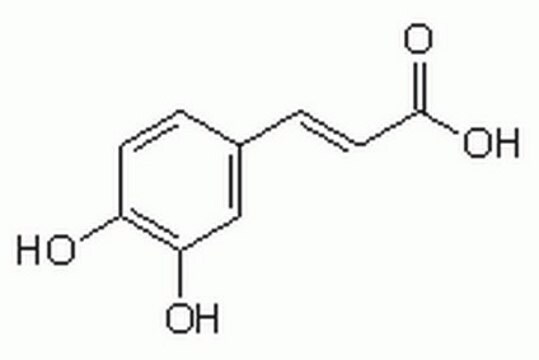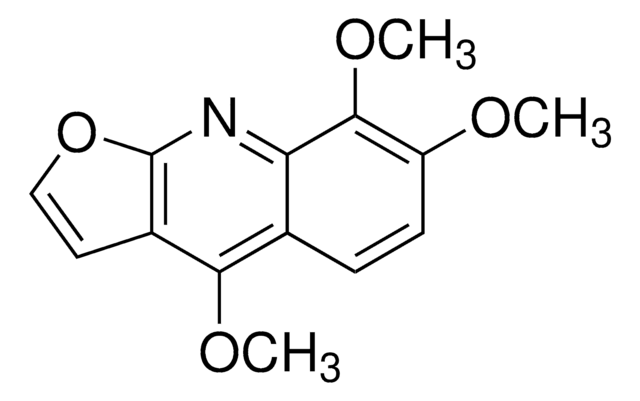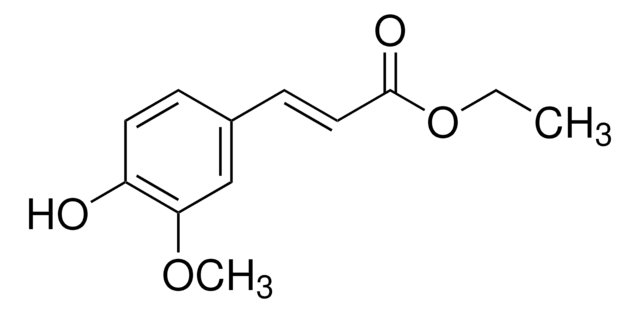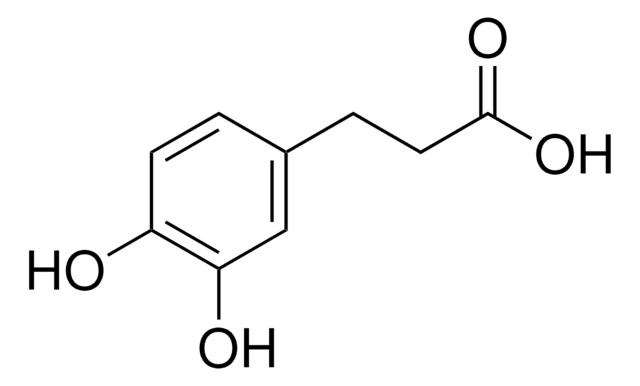C8221
Caffeic acid phenethyl ester
≥97% (HPLC), powder
Synonym(s):
CAPE
Sign Into View Organizational & Contract Pricing
All Photos(1)
About This Item
Empirical Formula (Hill Notation):
C17H16O4
CAS Number:
Molecular Weight:
284.31
MDL number:
UNSPSC Code:
12352108
PubChem Substance ID:
NACRES:
NA.77
Recommended Products
biological source
synthetic
Assay
≥97% (HPLC)
form
powder
storage condition
protect from light
color
off-white
solubility
ethyl acetate: 50 mg/mL
DMSO: soluble
ethanol: soluble
storage temp.
−20°C
SMILES string
Oc1ccc(\C=C\C(=O)OCCc2ccccc2)cc1O
InChI
1S/C17H16O4/c18-15-8-6-14(12-16(15)19)7-9-17(20)21-11-10-13-4-2-1-3-5-13/h1-9,12,18-19H,10-11H2/b9-7+
InChI key
SWUARLUWKZWEBQ-VQHVLOKHSA-N
Gene Information
human ... NFKB2(4791)
Application
Caffeic acid phenethyl ester (CAPE) has been used to determine the effect of CAPE in hyperthyroidism, as a component of culture media to measure the cytotoxicity of breast cancer cell line MDA-MB-231, to study its effects on amiodarone-induced pulmonary fibrosis in rats.
Biochem/physiol Actions
CAPE exhibits several properties such as anticarcinogenic, immunomodulatory activities, antioxidant, antiviral, anti-inflammatory, hypoglycaemic effect, cardioprotective and inhibits gastric secretion. It also has an inhibitory effect on fibroblasts growth factor type 2 (FGF-2), a tumor growth factor in breast cancer.
Caffeic acid phenethyl ester is a specific inhibitor of the nuclear transcription factor NF-κB.
Features and Benefits
This compound is a featured product for Gene Regulation research. Click here to discover more featured Gene Regulation products. Learn more about bioactive small molecules for other areas of research at sigma.com/discover-bsm.
Storage Class Code
11 - Combustible Solids
WGK
WGK 3
Flash Point(F)
Not applicable
Flash Point(C)
Not applicable
Personal Protective Equipment
dust mask type N95 (US), Eyeshields, Gloves
Choose from one of the most recent versions:
Already Own This Product?
Find documentation for the products that you have recently purchased in the Document Library.
Customers Also Viewed
Z Z Su et al.
Anticancer research, 15(5B), 1841-1848 (1995-09-01)
The active component of the folk medicine propolis, caffeic acid phenethyl ester (CAPE), displays selective toxicity toward cloned rat embryo fibroblast (CREF) cells transformed by a spectrum of diverse acting oncogenes. Identification of the mode of action of CAPE should
Mehdi Derakhshani et al.
Life sciences, 232, 116598-116598 (2019-06-28)
Hematopoietic stem cells (HSCs) are a rare cell population in adult bone marrow, mobilized peripheral blood, and umbilical cord blood possessing self-renewal and differentiation capability into a full spectrum of blood cells. Bone marrow HSC transplantation has been considered as
Protective effect of caffeic acid phenethyl ester (CAPE) on amiodarone-induced pulmonary fibrosisin rat
Zaeemzadeh N, et al.
Iranian Journal of Pharmaceutical Research : IJPR, 10(2), 321-321 (2011)
Migration rate inhibition of breast cancer cells treated by caffeic acid and caffeic acid phenethyl ester: an in vitro comparison study
Kabala-Dzik A, et al.
Nutrients, 9(10), 1144-1144 (2017)
Z Z Su et al.
Cancer research, 54(7), 1865-1870 (1994-04-01)
The active component of the honeybee hive product propolis, caffeic acid phenethyl ester (CAPE), induces a selective growth suppressive and toxic effect toward cloned rat embryo fibroblast cells transformed by adenovirus type 5 (Ad5) or the Ad5 E1A transforming gene
Our team of scientists has experience in all areas of research including Life Science, Material Science, Chemical Synthesis, Chromatography, Analytical and many others.
Contact Technical Service